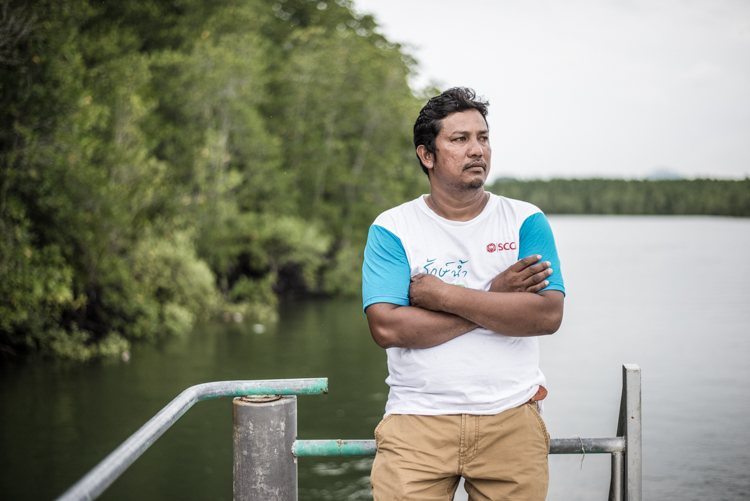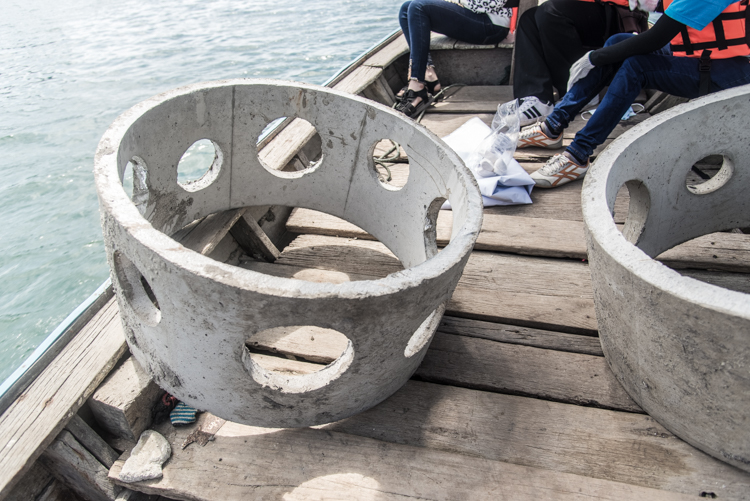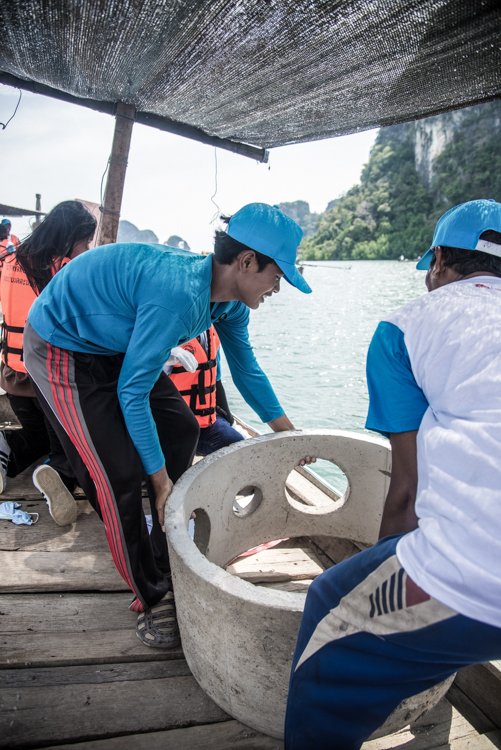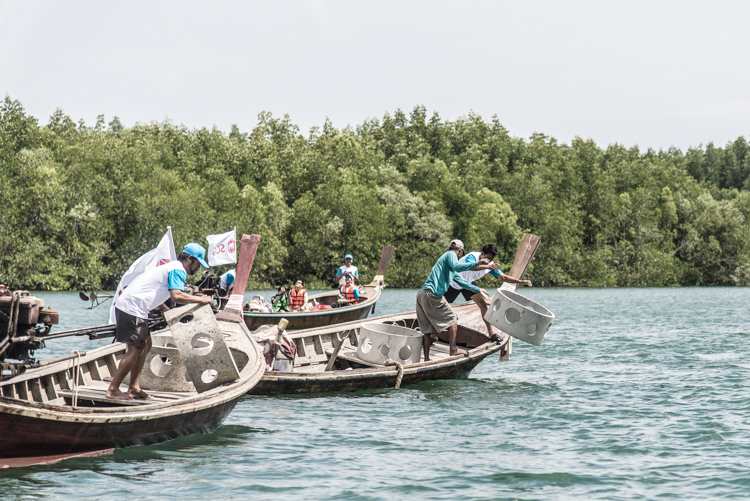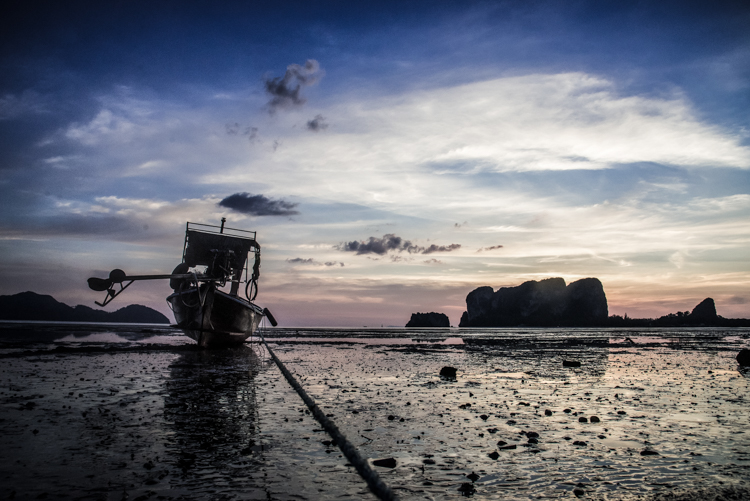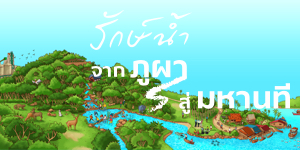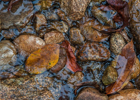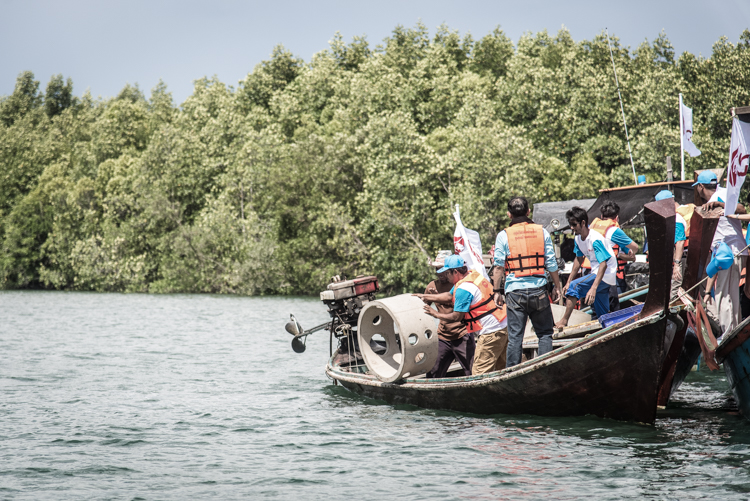
“Small Boats Should Leave the Shore”
Fish Homes for Natural Abundance and Sustainable Way of Life for Fishermen
“Fishermen should be cautious, and small boats should not leave the shore,” is often heard at the end of weather forecast announcements by the Thai Meteorological Department during the periods that the Andaman Sea is affected by the southwest monsoon from June to September each year, resulting in frequent rainstorms and waves that are 2 to 3 meters high.
Many call this period the ‘monsoon season.’
During the monsoon season, phrases such as wave heights, or the phrase ‘small boats should not leave the shore’ are familiar to audiences of weather forecasts, but undeniably, these words have little meaning to the daily lives of the general public.
However, near the coasts of the Andaman sea, at least one group of people closely follow the weather forecast from the Thai Meteorological Department as it affects income for their families, their daily lives and their livelihood.
They are coastal fishermen or local fishermen.
1
Fifty kilometers from Trang city center towards Koh Libong Sub-District, Kantang District, on the Trang river basin, is the local fishing community of 320 households. Most of the community’s inhabitants are Muslims, and they call their community ‘Mod Tanoy’ which means ‘Ant.’
“Everyone in the Mod Tanoy community fish for a living,” Bang Cha – Preecha Chaitui, the 40 year old community leader confirmed.
Two or three hours before the sunrise, fishermen in Mod Tanoy Community would start their small fishing boats to fish in a distance of no more than 20 kilometers from land. Apart from the use of large fishing nets, they utilized local wisdom passed on through the generation to fish. Moreover, they were careful to preserve natural resources such as coral reef or natural rock formations which were habitats of small sea creatures. They also fished cautiously as to prevent the number of sea animals from decreasing too much which can affect the ocean’s ecology and biological diversity.
“Fishermen in the past would use poison, dynamite, or even hauling nets, but not anymore, I can guarantee you,” said Bang-Cha. Those were the times before the Mod Tanoy fishing community realized that those methods do not lead to sustainable local fishing.
Coordination among fishermen to fish legally alongside the preservation of large mangrove forests, planting seagrass, waste management, developing conservation tourism and establishing a crab bank were all tangible projects carried out with the awareness to preserve natural resources of Mod Tanoy locals.
However, as long as the effects of monsoon season are factors beyond human control, fishermen who conserve nature must accept the truth that they cannot make income from the ocean throughout the monsoon season. Moreover, climate changes such as higher temperatures and increasing rain volume had resulted in lower number of sea animals, just one of the numerous problems that fishermen had been facing in the past few years.
That is, until’ Mod Tanoy Community’ learnt about ‘Fish Homes.’
2
Habitats for sea animals made by humans are nothing new for locals in Mod Tanoy Community. In the past, they experimented with coconut leaves that were put in water sources and coastal areas. Though results were satisfactory with a higher number of sea animals caught, the material were not permanent and easily washed away by the waves.
Problems encountered by the Mod Tanoy Community living in ‘downstream’ areas led to the development of fish homes. With the joint effort between the community, SCG, Koh Libong Non-Fishing Area, Department of National Park, Wildlife and Plant Conservation, Andaman Foundation and Duyong Protection Group, the “Raknam…From the mountains to the mighty rivers” project was continued in this area.
The innovation of seawater resistant cement was a key factor of fish homes that can withstand erosion from chloride and sulfate, enabling them to be used underwater for long periods of time. Research carried out by the Faculty of Engineering, Prince of Songkla University also confirmed that the material do not contain any substances harmful to the environment.
The heart of the project, however, was not the modern material, but the cooperation of the community since the very beginning. In designing fish homes to cater to the needs of fishermen who knew best about their local area, SCG believed that communication will create a deeper understanding and lessen any obstacles to the project.
“In every step of the project, we focused on open communication to create an understanding with locals while also inviting them to take part in the project. The community was determined to carry out the project and also saw the benefit of fish homes, thus, there were no obstacles during the operation. SCG was also determined to work closely with the community until they can carry out the project on their own,” said Chana Poomee, Vice President – SCG Cement and Construction Solution Business.
3
The bright skies on March 23, 2018 were a good sign for the day that everyone came together to plant the fish homes.
Lad Chao Mai stream was an emerald green color amidst the lush mangrove forest, and some distance away, limestone hills rose to the sky, proving the diversity of the coastal ecology that has been named one of the significant wetlands or a Ramsar site. This stream that connected the lives in Mod Tanoy to the rich ocean waters was where the fish homes will be placed as designated by the needs of the community, SCG, and Koh Libong Non-Fishing Area.
A total of 80 fish homes made from seawater resistant cement were carried on over 50 small boats out to Lad Chao Mai stream where brackish water flowed. Apart from locals in the community, government representatives and staff from SCG, the group that seemed the most excited about this activity were youths in the water conservation project who wanted to carry on the sustainable water management program.
After the fish homes were placed in Lad Chao Mai stream, Muan Long-A, a third-year student at Prince Songkla University, Pattani Campus, revealed that she hoped that the fish homes will directly benefit the fishing community and offer food year-round. During the monsoon season, though they will have no income, but at least they will not have more expenses.
Chana had planned to place a total of 400 fish homes in several communities throughout 2018, with 200 of these carried out by SCG in cooperation with local networks, and the other 200 carried out independently by locals. To monitor and assess the project, SCG has been cooperating with the Center for Biodiversity of Peninsular Thailand of Prince Songkla University to carry out research on the biodiversity of the areas in the project, from pre-operation to periodical monitoring after the operation.
The fish homes placed in the Trang river basin were a result of the joint efforts of a strong community, the private and public sector and civil society and will become a habitat and conservation for young sea animals and adding to the abundance of coastal resources. The fish homes are crucial to the way of life of locals in Mod Tanoy Community and it means that they will not have to take risks to go out to sea during the monsoon season. This project has enabled the community to become more sustainable and independent through tough times.
“We fishermen will be in trouble if we do not conserve nature,” said Bang-Cha to youths in the water conservation project on their community field trip.
Along the 119 kilometers of shoreline in Trang, there are over 44 communities where their main source of income is fishery. The success at Mod Tanoy Community which is a part of the “Raknam…From the mountains to the mighty rivers” project will be passed on from community to community and become the power to conserve natural resources in the ocean as well as rare marine animals found in the area from dugongs, dolphins, to sea turtles, all of which are factors indicating biodiversity.
If this becomes a reality…
“Small boats should not leave the shore” announcements from the Thai Meteorological Department will no longer be a frightening phrase for local fishermen anymore.
